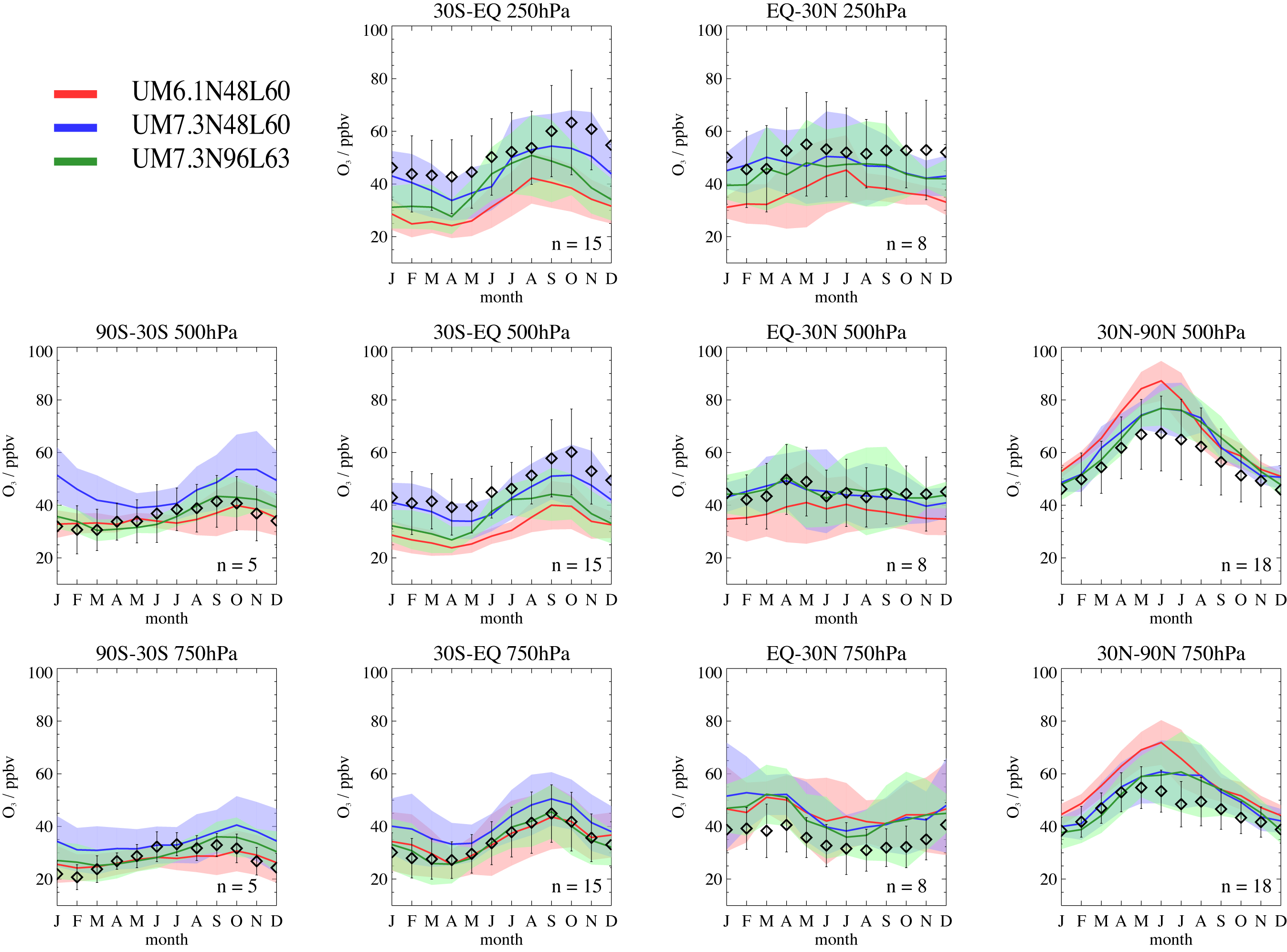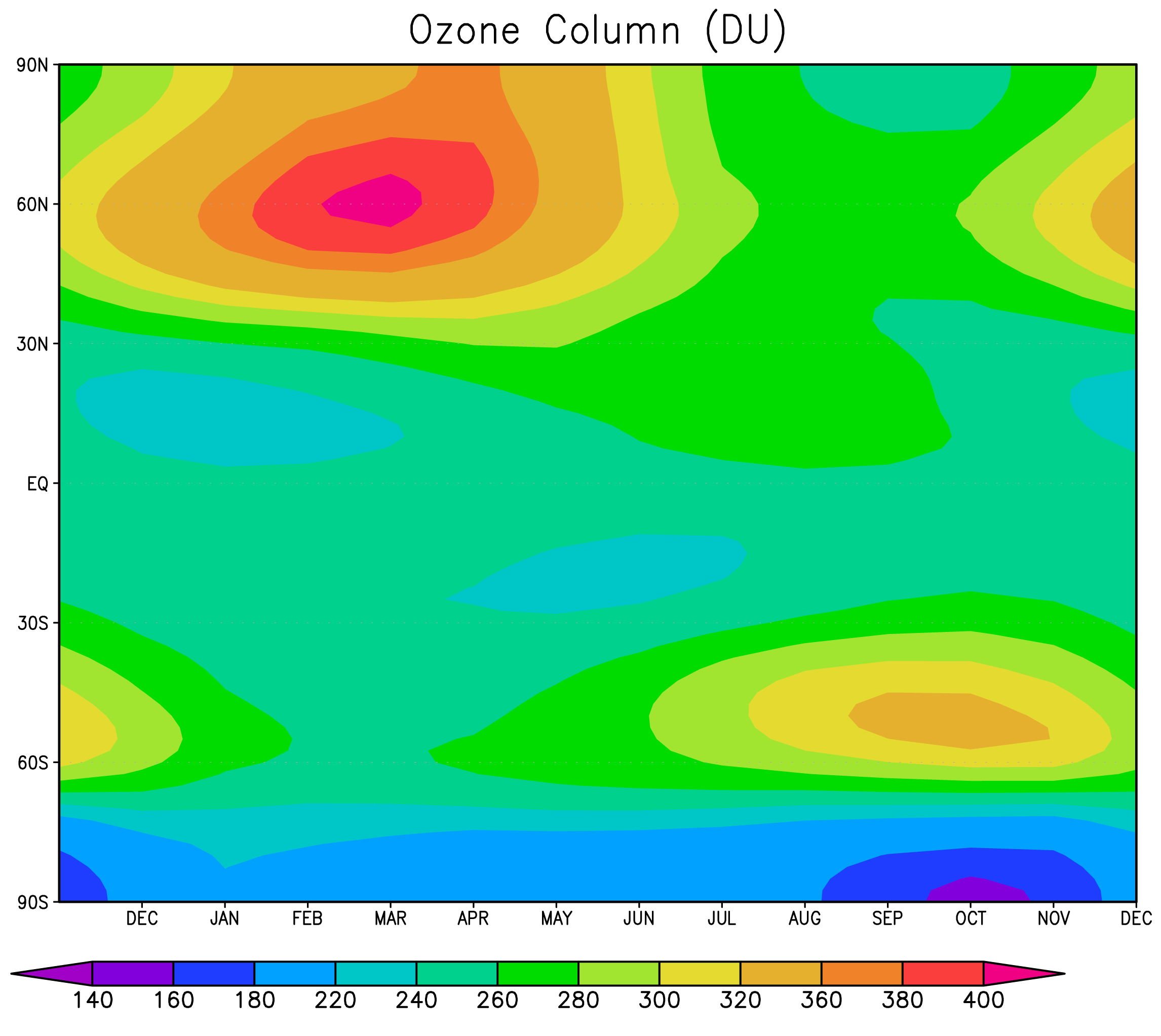Difference between revisions of "UKCA Release Jobs"
(→Useful Links: and add another) |
(→Timings: note re phase 2) |
||
| Line 72: | Line 72: | ||
===Timings=== |
===Timings=== |
||
| − | It should be noted that due to "jitter" on the HPC platform, all timings are approximate. As a simulation progresses the time per model month may increase as the fields spin-up from their initial state. |
+ | It should be noted that due to "jitter" on the HPC platform, all timings are approximate. As a simulation progresses the time per model month may increase as the fields spin-up from their initial state. Please also note that the MONSooN timings are for phase 1 - jobs will run more quickly on phase 2 and you should consider using more nodes than on phase 1. |
{| border="1" cellpadding="2" |
{| border="1" cellpadding="2" |
||
Revision as of 08:58, 7 September 2012
This page contains documentation on UKCA standard jobs that have been released or will soon be released.
You may also wish to look at the bugfixes page.
Getting Started
PUMA
The UK Met Office's Unified Model (UM) is provided for the NERC community from NCAS Computational Modelling Services via the PUMA (Providing UM Access) resource. To use UKCA you must have an account on PUMA. To obtain one, please go to the NCAS-CMS PUMA page.
FCM
The UM uses code management software, built around subversion, called FCM (Flexible Configuration Management).
If you have not used the UM with FCM, we ask that you first familiarise yourself with the system by doing the UM FCM Tutorial.
As well as being a good introduction to FCM and the UM User Interface (UMUI), it will also teach you how to set-up some configuration files that will be needed in the day-to-day running of the UM and UKCA.
Standard Release Jobs
UKCA can be configured through the UMUI, via it's own configuration panel. This mostly controls all the options required to run UKCA, although some extra changes have been made with hand-edits. To make it easy to get started with UKCA, several standard jobs have been created at various resolutions. To get started with UKCA, it should be a simple matter to take a copy of the UKCA job that you wish to run, changing a few user-specific options, and submitting the job.
Code Changes
To run a UKCA standard job, please take a copy of one of the jobs listed below. If you need to make code changes, you must make a new FCM branch, and merge in the UKCA branch which is used in the job that you are taking, then use your branch instead.
Please do not take a checkout of the UKCA branch used in the UMUI FCM panel (e.g. fcm:um_br/dev/luke/VN7.3_UKCA_CheM) and run from this as a working copy. If the fcm commit command is run from this directory it would commit any changes you have made to this branch. In this case, this would affect the branch for other UKCA users.
Job List
Available release jobs are:
| UM Version | UMUI Job-ID | Climate Model | Horizontal Resolution | Vertical Levels | Model Top | Scheme Used | FCM Branch | Revision Number |
|---|---|---|---|---|---|---|---|---|
| 7.3 | HECToR:xfvfa,xfvfc MONSooN: xfvfb |
QESM-A | N48 (2.5°×3.75°) | L60 | ~84km | Tropospheric Chemistry with Isoprene | fcm:um_br/dev/luke/VN7.3_UKCA_CheM | 9278 |
| 7.3 | HadGEM3-A r2.0 | N96 (1.25°×1.875°) | L63 | ~40km | Tropospheric Chemistry with Isoprene | fcm:um_br/dev/luke/VN7.3_UKCA_CheM | 9278 | |
| 7.3 | HECToR:xfvga,xfvgc MONSooN:xfvgb |
QESM-A | N48 | L60 | ~84km | Stratospheric Chemistry | fcm:um_br/dev/luke/VN7.3_UKCA_CheM | 9278 |
| 7.3 | HadGEM3-A r2.0 | N96 | L85 | 85km | Stratospheric Chemistry | fcm:um_br/dev/luke/VN7.3_UKCA_CheM | 9278 | |
| 7.3 | QESM-A | N48 | L60 | ~84km | Simple Tropospheric Chemistry with MODE Aerosol | |||
| 7.3 | HECToR: MONSooN:xfxlb |
N96 | L38 | ~40km | Simple Tropospheric Chemistry with MODE Aerosol | fcm:um_br/dev/mdalvi/VN7.3_MODEBLN_Rad_Indir | 5953 | |
| 7.3 | HECToR: MONSooN:xfxld |
N96 | L38 | ~40km | Simple Tropospheric Chemistry with MODE Aerosol (Nudged) | fcm:um_br/dev/mdalvi/VN7.3_MODEBLN_Rad_Indir fcm:um_br/dev/mdalvi/VN7.3_nudged_new | 5953 5586 |
Required UMUI Changes
Before submitting a UKCA job, you must first alter several options in the UMUI:
- User-id, Mail-id (email address), and Tic-Code:
Model Selection -> User Information and Target Machine -> General Details
The user-id is your username on the target machine (i.e. HECToR).
The tic-code will be the HECToR charging code, e.g. n02-chem. This code can be found by logging into the HECToR SAFE pages, and viewing your account information. - Target machine root extract directory (UM_ROUTDIR):
Model Selection -> FCM Configuration -> FCM Extract and Build directories and Output levels
This needs to be the full path to one of your directories on the target machine (HECToR /home directory or MONSooN /projects directory).
See also: Using the UMUI for information on Optional UMUI changes such as changing the run length, archiving, emissions etc
Tropospheric Chemistry with Isoprene - TropIsop
This scheme using the FCM branch fcm:um_br/dev/luke/VN7.3_UKCA_CheM at revision 9278 (updated). It has 56 species (49 of which are tracers), 115 bimolecular reactions, 35 photolysis reactions (using rates determined using a 2D look-up table) and 15 termolecular reactions. 23 species are wet-deposited and 32 are dry-deposited (using a 2D dry-deposition scheme). Tropospheric and budgets are outputted as standard, as are other diagnostics of interest, such as the lifetime and Stratosphere-Troposphere Exchange of .
The chemistry is integrated using the ASAD chemical package, using a sparse-matrix Newton-Raphson solver. While the UM dynamical timestep is every 20 model minutes, chemistry is called every model hour, although emissions are still performed every dynamical timestep. Top boundary conditions are used for and and is treated as a constant. The tracers are initialised to spun-up fields from a previous TropIsop run, however, we recommend that a 15 month-spin-up should be performed.
The chemistry scheme used in these simulations is the same as in Telford et al, Atmos. Chem. Phys., 10, 7117-7125, doi:10.5194/acp-10-7117-2010 (2010). A model description paper is also in preparation (O'Connor et al, 2011).
The tropospheric ozone concentrations in UKCA-TropIsop are biased slightly high. This is improved with using an interactive photolysis scheme, which will be released for general use soon.
Timings
It should be noted that due to "jitter" on the HPC platform, all timings are approximate. As a simulation progresses the time per model month may increase as the fields spin-up from their initial state. Please also note that the MONSooN timings are for phase 1 - jobs will run more quickly on phase 2 and you should consider using more nodes than on phase 1.
| Machine | No. of Cores | No. of Nodes | Resolution | Time for 1 Model Month |
|---|---|---|---|---|
| HECToR Phase2b | 96 | 4 | N48L60 | ~50 minutes |
| MONSooN | 64 | 2 | N48L60 | ~59 minutes |
Stratospheric Chemistry - StratChem
- See also Stratospheric Chemistry description page.
This scheme using the FCM branch fcm:um_br/dev/luke/VN7.3_UKCA_CheM at revision 9278 (updated). It has 41 species (36 of which are tracers), 113 bimolecular reactions, 34 photolysis reactions (using rates determined using a 3D look-up table), 17 termolecular reactions and 5 heterogeneous reactions. 15 species are wet-deposited and 15 are dry-deposited (using a 2D dry-deposition scheme). A stratospheric is standard (based on the budget of Lee et al, JGR 107 DOI:10.1029/2001JD000538 (2002)), as are other diagnostics of interest, such as the lifetime and Stratosphere-Troposphere Exchange of .
The chemistry is integrated using the ASAD chemical package, using a sparse-matrix Newton-Raphson solver. While the UM dynamical timestep is every 20 model minutes, chemistry is called every model hour, although emissions are still performed every dynamical timestep. By default, lower boundary conditions set for the tracer concentrations of , , , , , , and are specified for the years 1950-2100. These values are also used in the UM radiation scheme, along with concentrations. The tracers are initialised to spun-up fields from a previous StratChem run, however it can take time for a Stratospheric run to equilibrate and spin-up times as long as 20 model years may be required if significant changes are made.
The chemistry scheme used in these simulations is the similar to that described in Morgenstern et al, Geosci. Model Dev., 2, 43-57, (2009).
Please also see the bugfixes page for further information on the initial conditions used in the release job.
Timings
It should be noted that due to "jitter" on the HPC platform, all timings are approximate. As a simulation progresses the time per model month may increase as the fields spin-up from their initial state.
| Machine | No. of Cores | No. of Nodes | Resolution | Time for 1 Model Month |
|---|---|---|---|---|
| HECToR Phase2b | 96 | 4 | N48L60 | ~46 minutes |
| MONSooN | 64 | 2 | N48L60 | ~51 minutes |
Simple Tropospheric Chemistry with GLOMAP-mode aerosol - UKCA-MODE
- See also MODE Aerosol description page.
The UKCA aerosol scheme 'GLOMAP-mode' (sometimes called UKCA-MODE when in the UM) is described in detail in Mann et al (2010) and simulates aerosol microphysics (nucleation, condensation,coagulation and cloud processing), dry deposition, sedimentation and in-cloud/below-cloud scavenging. The scheme simulates atmospheric aerosol in a size-resolved manner with the chemical and aerosol microphysical processes determining the evolution of the size and composition of several size modes. The scheme transports the mass of sulphate, sea-salt, black carbon, organic matter and dust, along with the particle number concentration in each size mode. The aerosol scheme is coded flexibly to allow the same code to run with several alternative aerosol configurations via FORTRAN-90 modules.
UKCA-MODE can be coupled to all of the various UKCA chemistry schemes, but in this standard job uses the simple tropospheric chemistry scheme, extended to treat the degradation of the aerosol precursor species: sulphur dioxide (SO2);dimethylsulphide (DMS); and a lumped monoterpene tracer.
An interface between UKCA-MODE and the Edwards-Slingo radiation scheme allows the aerosol concentrations to interact with the radiation both directly (through scattering and absorption of incoming solar and outgoing long-wave radiation) and indirectly via modified cloud albedo. In the standard jobs, both these effects are computed in a passive/ diagnostic mode via use of a double-call to the radiation scheme.
One of the standard jobs also includes Nudging, wherein the model dynamics variables are nudged or relaxed towards ECMWF Reanalysis data. This configuration is particularly useful for evaluating the MODE scheme against measurements.
Timings
When run with all the 31 aerosol tracers switched on, the UKCA-MODE code adds 12% to the cost of the Atmosphere model (see O'Connor et al, 2011 ICP report to DECC/DEFRA).
| Machine | No. of Cores | No. of Nodes | Resolution | Time for 1 Model Month |
|---|---|---|---|---|
| MONSooN (non-nudged) | 64 | 2 | N96L38 | ~2 hours |
| MONSooN (nudged) | 64 | 2 | N96L38 | ~2.5 hours |













